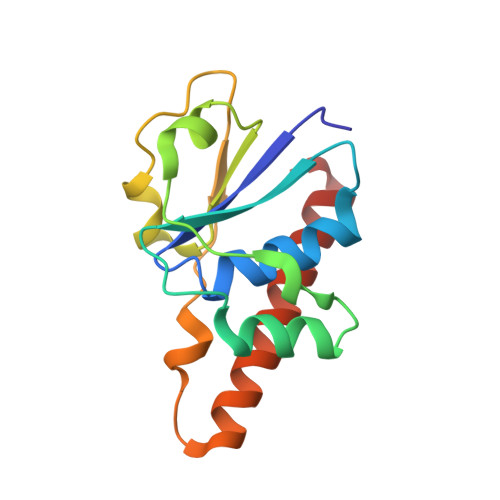Solution Structures and Backbone Dynamics of Arsenate Reductase from Bacillus subtilis: REVERSIBLE CONFORMATIONAL SWITCH ASSOCIATED WITH ARSENATE REDUCTION
Guo, X., Li, Y., Peng, K., Hu, Y., Li, C., Xia, B., Jin, C.(2005) J Biol Chem 280: 39601-39608
- PubMed: 16192272
- DOI: https://doi.org/10.1074/jbc.M508132200
- Primary Citation of Related Structures:
1Z2D, 1Z2E - PubMed Abstract:
Arsenate reductase encoded by the chromosomal arsC gene in Bacillus subtilis catalyzes the intracellular reduction of arsenate to arsenite, which is then extruded from cells through an efficient and specific transport system. Herein, we present the solution structures and backbone dynamics of both the reduced and oxidized forms of arsenate reductase from B. subtilis. The overall structures of both forms are similar to those of bovine low molecular weight protein-tyrosine phosphatase and arsenate reductase from Staphylococcus aureus. However, several features of the tertiary structure and mobility are notably different between the reduced and oxidized forms of B. subtilis arsenate reductase, particularly in the P-loop region and the segment Cys(82)-Cys(89). The backbone dynamics results demonstrated that the reduced form of arsenate reductase undergoes millisecond conformational changes in the functional P-loop and Cys(82)-Cys(89), which may facilitate the formation of covalent intermediates and subsequent reduction of arsenate. In the oxidized form, Cys(82)-Cys(89) shows motional flexibility on both picosecond-to-nanosecond and possibly millisecond time scales, which may facilitate the reduction of the oxidized enzyme by thioredoxin to regenerate the active enzyme. Overall, the internal dynamics and static structures of the enzyme provide insights into the molecular mechanism of arsenate reduction, especially the reversible conformational switch and changes in internal motions associated with the catalytic reaction.
Organizational Affiliation:
Beijing Nuclear Magnetic Resonance Center and the College of Chemistry and Molecular Engineering, Peking University, Beijing 100871, China.














